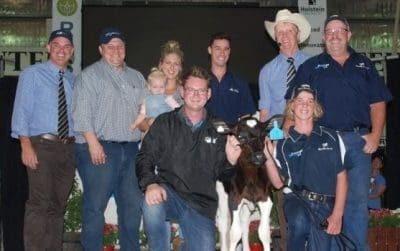LAST month a 12-week-old Australian Holstein dairy heifer calf sold at auction for $251,000 during International Dairy Week at Tongala in Victoria’s Goulburn Valley.
You might well ask, given the dairy industry’s current problems, why would an untested youngster bring the second highest price* ever paid for a bovine (beef or dairy cattle) in Australia’s history? And are we ever likely see such lofty prices in the beef industry?
Genomic prediction could be the answer, and the process is far more advanced in the dairy industry currently than it is in beef.

Owner Declan Patten with his Holstein heifer calf Gigi and buyer connections after last month’s $251,000 record sale.
The record breaking heifer, sold at at under the hammer of Brian Leslie of Ruralco’s Dairy Livestock Services during the World Wide Series Evolution Sale, has the highest Genomic Total Performance Index (GTPI) of any animal ever to be sold in the world, and is the fourth highest GPTI Holstein ever.
Genomics testing using simple DNA sampling, is creating a true international market for dairy genetics, with the calf, Lightning Ridge CMD Jedi Gigi, being sold to US interests.
She was purchased by the Texas-based company Sexing Technologies, and will be exported from Australia as soon as protocols have been met. It is assumed the latest artificial breeding technologies will quickly generate a group of descendants that will hopefully replicate the calf’s superior genetic performance.
The losing bidder was the giant Canadian based genetics company Semex.
Vendors were American, Callum Moscript and Victorian, Declan Patten, who together bought a highly credentialed Canadian heifer several years ago and her embryos ended up in Australia resulting in this calf.
Challenge in measuring desirable beef traits
Genetic discovery in dairy cattle is said to be simpler than in beef cattle, primarily because desirable traits are easier to record. The dominant dairy traits of milk volume and milk composition can be measured, if necessary, twice a day during lactation.
In contrast the dominant beef traits are growth and carcase quality related. Growth is typically measured two of three times in a seedstock herd animal’s lifetime while carcase can be measured accurately only once. Therefore rapid data accumulation is much easier in the dairy population.
DNA results from the record-breaking calf were analysed under the American Holstein genomics analysis system revealing the animal’s unique qualities.
Australia has some excellent genomic based genetic discovery systems according to Holstein Australia’s CEO Graeme Gillan who claimed that the US led the world in genetic analysis in the dairy industry.
“Even Canada and Europe are using the US genomic discovery systems to identify their top genetics,” he said.
Every young Holstein bull going into AI has now been selected through genomic testing.
“Years ago the industry would select 100 AI sires from a group of say 300 using traditional performance recording methods. Today, using genomics, the industry can test 3000 bulls to come up with the best 100, meaning the very best are discovered,” he said.
“Genomic selection in the dairy industry is contributing 60pc to accuracies, the equivalent of 35 to 40 daughters for a bull or seven lactations for a heifer.”
Mr Gillan said Australia was very fortunate to have some world-leading scientists in the genomics field in livestock.

Ben Hayes
Australian researcher Professor Ben Hayes has extensive research experience in genetic improvement of livestock, crop, pasture and aquaculture with a focus on integration of genomic information into breeding programs.
Genomic prediction, of which Prof Hayes was a co-inventor, is now being used widely in livestock and crops to predict future trait outcomes. The technology is also being used increasingly in human disease research.
Prof Hayes said that in dairy cattle, the technology has been actively used for the past several years, and increases in genetic gain for key economic traits can be demonstrated.
He said nearly every dairy bull worldwide chosen for widespread use is now selected on the basis of genomic predictions.
As highlighted in this earlier Beef Central article, last year Prof Hayes was appointed a Professorial Research Fellow at the University of Queensland’s Queensland Alliance for Agriculture and Food Innovation, where he is focusing on northern Australian beef production and how genomic prediction can be used to drive productivity in this sector.

Carel Tesseling
The Wagyu Association’s Carel Teseling said that data from 5000 Wagyu carcases had already been genotyped in a completed MLA-backed project while MLA has approved the next step of collecting data from 10,000 Wagyu X Angus and Wagyu X Brahman carcases to accelerate genotyping in the breed.
The Wagyu industry’s innovative ‘one step genomics’ is also well advanced, by beef industry standards.
What is genomics, and what does it offer the industry?
Having led the beef industry in adopting performance recording, Angus breeders across Australia are also now utilising the latest generation of breeding and genetic technology, genomics, in increasing numbers according to Angus Australia’s Andrew Byrne.
Mr Byrne explained that genomics is the term given to describe a range of DNA based technologies concerned with the structure, function, evolution and mapping of genomes, being the complete set of genes present in an organism.

Andrew Byrne
“Genomics has several main applications in the beef industry, including traceability through the supply chain, and verification of breed content for branded beef products. But it is predominantly used in Angus breeding for determination of parentage, management of the unfavorable genetic conditions, and more recently, for the identification of animals with superior genetic merit,” he said.
“Compared with traditional genetic evaluation technologies, the incorporation of genomic information enables more accurate selection decisions to be made, particularly in situations where an animal’s traditional EBV has low accuracy – for example, when an animal is very young, or for traits that are hard to measure or have low heritability.”
More than 18,000 animals now have genomic information incorporated in the Angus BreedPlan genetic evaluation, with genomic information collected on animals bred in more than 350 herds. About 80 of these herds have collected genomic information on 25 animals or greater.
So the beef industry may be starting to catch-up to dairy in the genomics field, but will we ever see a $251,000 12-week-old beef calf? Maybe genomic testing is the answer.
Last week’s autumn bull sales: Black Simmies shine in the west
Bonnydale Black Simmentals and SimAngus at Bridgetown, WA, on Monday had a 100 percent clearance of 66 bulls to average $8240 at their annual autumn sale. The result was a 27pc jump on last year’s $6500 average for 50 bulls. All the bulls sold this year were yearlings, with a top of $12,500. Significantly, 11 sold to eastern states buyers, including nine to Queensland.
- Click this link to access our full summary of recent autumn bull sales.
- Click this link to access our full summary of upcoming autumn/spring bull sales.
* Beef Central maintains an aggregated list of current Australian beef cattle breed record prices. Click this link to view the report, also accessible via our genetics category page.



And this focus on production traits delivers cows that have a shorter production lifespan and can only operate in selective production environments to their genetic potential. It’s like a car with big horsepower that can’t be used anywhere but a restricted environment.
Current selection in the mainstream dairy business is a hell of a lot different than for beef…………as they primarily practice single trait selection.
A very interesting article and findings
the dairy heifer sale also shows how restricted to trade within Australia by the johnes regulations
that heifer can go to the usa but cant go to west Australia
the new johnes regulations are still a farce as west Australia which has endemic OJD still uses BJD regulations as a trade barrier by backed certain stud breeders with self interest